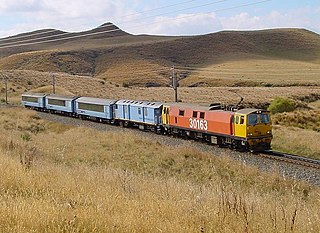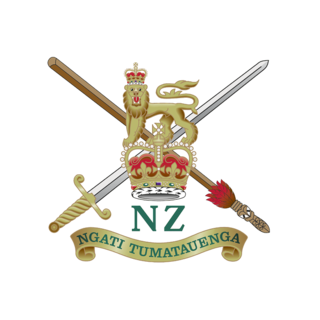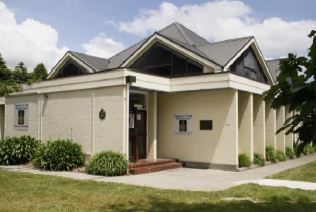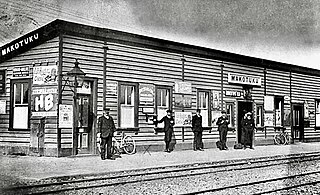
Palmerston North is a city in the North Island of New Zealand and the seat of the Manawatū-Whanganui region. Located in the eastern Manawatu Plains, the city is near the north bank of the Manawatu River, 35 km (22 mi) from the river's mouth, and 12 km (7 mi) from the end of the Manawatū Gorge, about 140 km (87 mi) north of the capital, Wellington. Palmerston North is the country's eighth-largest urban area, with an urban population of 81,200. The estimated population of Palmerston North city is 90,400.

Waiouru is a small town in the Ruapehu District, in New Zealand's Manawatū-Whanganui region. It is located on the south-eastern North Island Volcanic Plateau, 130 km (81 mi) north of Palmerston North and 25 kilometres south-east of Mount Ruapehu. The town had a population of 765 in the 2018 census.

Central Energy Trust Arena is the current name of the 180,000 square metre publicly owned recreational complex just west of the Palmerston North city centre in the Manawatū-Whanganui region of New Zealand.

The New Zealand Army is the principal land warfare force of New Zealand, a component of the New Zealand Defence Force alongside the Royal New Zealand Navy and the Royal New Zealand Air Force.

The Royal New Zealand Signals Corps (RNZSigs) provides, co-ordinates and operates the communications networks of the New Zealand Army. The role of RNZSigs is to support other Arms by providing Communication Information System required for Command and Control of Units, Formations and Administrative installations in a theater of Operations and in the New Zealand support area. Modern signal equipment is essential to the army, demanding skilled operators and technicians. Because communications must be maintained even under the worst of conditions, signallers must be expert tradespeople. They must also accept a high degree of personal responsibility because the lives of soldiers can often rely on the fast and accurate transmission of battlefield information.

The Corps of Royal New Zealand Engineers is the administrative corps of the New Zealand Army responsible for military engineering. The role of the Engineers is to assist in maintaining friendly forces' mobility, deny freedom of movement to the enemy, and provide general engineering support. The corps has been involved in numerous conflicts over the course of its history including World War I, World War II, the Korean War, the Vietnam War and the war in Afghanistan. The corps consists of a single regiment, 2nd Engineer Regiment, primarily based at Linton Military Camp near Palmerston North.

The Royal New Zealand Army Logistic Regiment, is the New Zealand Army's main military Logistics and combat service support (CSS) element. It is the largest regiment in the NZ Army.

The Royal New Zealand Army Medical Corps (RNZAMC) is a corps of the New Zealand Army, the land branch of the New Zealand Defence Force (NZDF). The Medical Corps provides for the medical needs of soldiers, such as diagnosing and treating diseases and injuries. Medical personnel are part of almost all Army exercises and operations, and personnel work in conjunction with personnel from the Royal New Zealand Dental Corps and the Royal New Zealand Nursing Corps.
Linton is a suburb of Palmerston North, situated 11km south-west of the city.

Linton Military Camp is the largest New Zealand Army base and is home to the Headquarters 1(NZ) Brigade. It is located just south of Palmerston North.
Trentham Military Camp is a New Zealand Defence Force (NZDF) facility located in Trentham, Upper Hutt, near Wellington. Originally a New Zealand Army installation, it is now run by Defence and accommodates all three services. It also hosts Joint NZDF facilities including:

New Zealand's involvement in the Vietnam War was highly controversial, sparking widespread protest at home from anti-Vietnam War movements modelled on their American counterparts. This conflict was also the first in which New Zealand did not fight alongside the United Kingdom, instead following the loyalties of the ANZUS Treaty.
The National Army Museum is the museum of the New Zealand Army. It was formerly known as the Queen Elizabeth II Army Memorial Museum. It is located on State Highway One, on the southern side of the small military town of Waiouru. The 1300 square metre museum is fortress-looking in design, complete with a bridge and moat. It took the 2nd Field Squadron of the Royal New Zealand Engineers (RNZE) 276 days to build, and was opened in October 1978.

Papakura is a southern suburb of Auckland, in northern New Zealand. It is located on the shores of the Pahurehure Inlet, approximately 32 kilometres south of the Auckland CBD. It is under the authority of the Auckland Council.
The New Zealand Command and Staff College (NZCSC) is the premier educational institute for the New Zealand Defence Force (NZDF) and is located at Trentham Military Camp, Upper Hutt. The New Zealand Command and Staff College provides professional military education to New Zealand Defence Force officers which prepares officers for command and staff appointments. The college was established at Whenuapai, near Auckland, in 1950, as a school for junior officers of the RNZAF. In 2004, the college moved to its present location in Trentham Military Camp, Upper Hutt near Wellington, New Zealand. Courses follow a modular approach that incorporate the following core subjects: Communication Skills, Operational Studies, Strategic Studies, International Relations, Command, Leadership and Management. Due to the college's close association with Massey University, it is able to offer to successful graduates of the Advanced Command and Staff Course (Joint) the delivery, by Massey University's Centre for Defence and Security Studies, of 150 credits of the 180 credits required for gaining a Masters in International Security.

The 1st Brigade is currently the largest unit of the New Zealand Army, and contains most of the army's deployable units. The brigade was formed on 13 December 2011 by amalgamating the 2nd Land Force Group and 3rd Land Force Group. Its establishment formed part of the 'Army 2015' package of reforms.

This article describes the current structure of the New Zealand Army. It includes the army's order of battle and the headquarters locations of major units.
Rangiotu is a farming community in the Manawatū District and Manawatū-Whanganui region in New Zealand's central North Island.

Makotuku is a locality in the Manawatu-Whanganui Region of New Zealand's North Island, about 3 km2 (1.2 sq mi) west of Ormondville.















